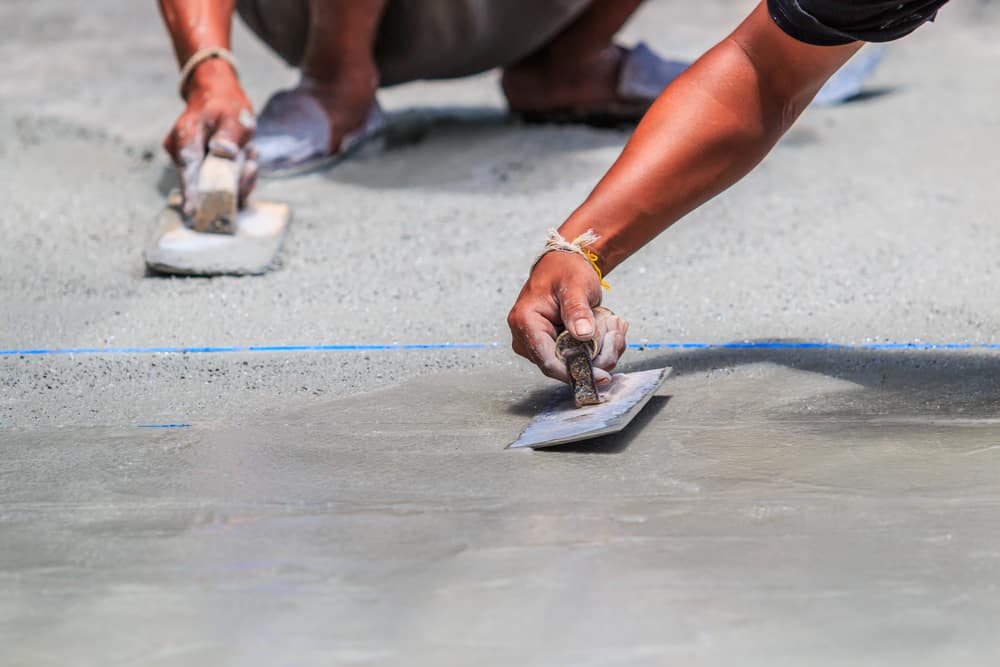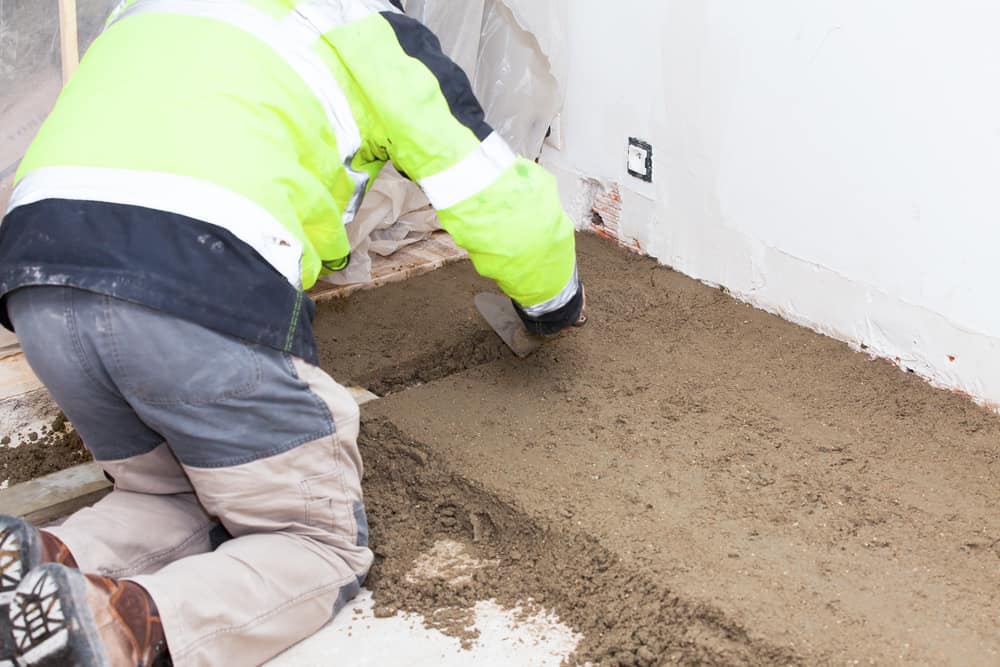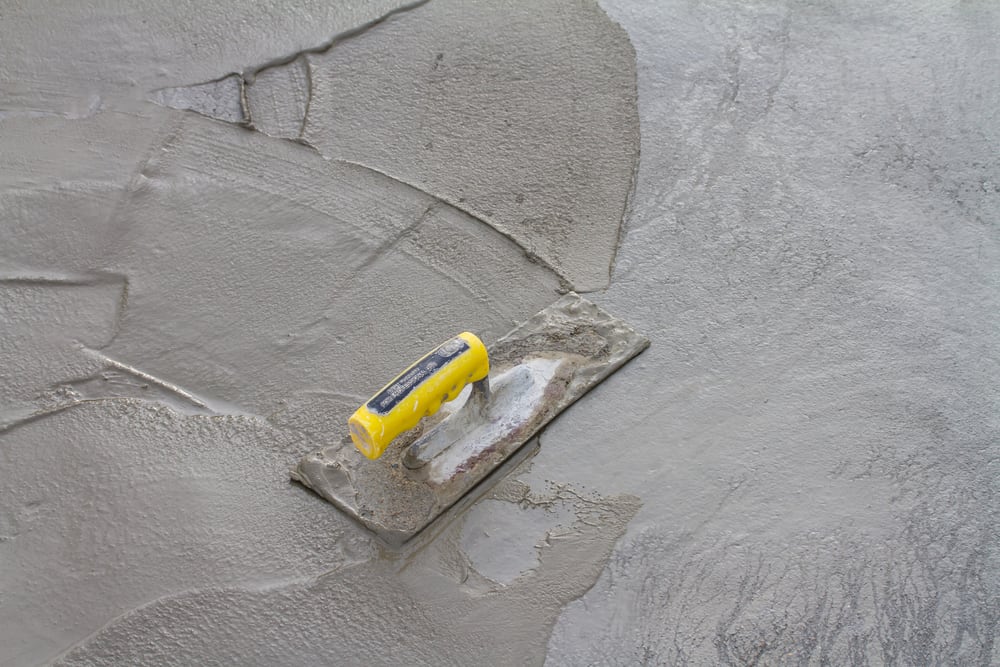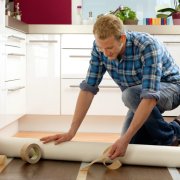Concrete for screed
A screed is an intermediate layer between the decorative flooring and the concrete base. The purpose of the device of such a layer is to strengthen the base to withstand the load, level the plane and prepare the base for a laminate, tile, parquet, linoleum or polymer coating. The mass for pouring is prepared from components that are selected according to the type of screed. In order to save costs, developers knead lightweight concrete for floor screed on their own.
The content of the article
Concrete composition for screed
Properly selected components and the proportional ratio in the mortar affect the final strength, external aesthetics and durability of the floor. There are seven types of screed:
- concrete;
- terrazzo (or mosaic);
- anhydride;
- xylolithic (magnesite);
- foam concrete;
- on synthetic resins;
- cast asphalt.
In residential premises, a common cheap option is used - concrete or foam concrete screed. For basements, workshops and garages choose cast asphalt, halls of hotels and public buildings are decorated with mosaic tiles.
Terrazzo
Concrete for screed is selected according to the design parameters of the technological tables, taking into account the thickness, load, floor area and purpose of the room.
- Concrete They are filled with a mass of cement M400 / 500 diluted with water in combination with crushed stone and sand. The mass has a gray tint. Ready-made factory sand concrete for screed is marked as M150 / 200 and packaged in bags of 25 or 50 kg.
- Terrazzo. The mixture for pouring consists of coloring pigments, stone chips and Portland cement. The mixture is poured over a concrete or cement base, forming a patterned decorative floor.
- Anhydride. They are arranged with mixtures of natural gypsum, calcined according to special technology. After pouring, a durable coating with a cream tint is formed.
- Magnesite. They are poured with a composition of sawdust mixture, water, sand, coloring pigment and xylolite cement. After hardening, a grayish coating forms with a smooth surface and wood splashes.
- Foam concrete. They are poured on a wooden, cement, concrete base without preparatory operations, they form a grayish surface with the characteristics of sound insulation and thermal insulation.
- On synthetic resins. The composition of the mixture for pouring includes polyurethane-based resins (or epoxy), the mass is laid on concrete screeds and forms a smooth glossy surface of the selected color.
- Cast asphalt. The filling mixture is heated to 250 degrees, laid and leveled by hand rollers. In the composition - fine-grained gravel, sand and bitumen. The result of the fill is a rough dark surface.
To equip the concrete screed, prepare the solution yourself from Portland cement, water and coarse river sand, or buy a ready-made packaged mixture. In the first embodiment, the materials will be cheaper, in the second it will not be necessary to calculate the exact proportions.
If the first option is chosen, carefully consider in what proportions to mix the ingredients. To help the novice master - the ratio table below.
Consumption of materials by grade of concrete
Using the table, determine what type of screed is required. The calculation calculator will show the amount of concrete costs by the area of the room and the number of constituent ingredients.
Good to know! To make the self-prepared solution easily fit, plasticizers are additionally added to the composition.
If you use factory mixtures, carefully read the instructions and data on the composition, look at the explanatory notations, for example, “concrete for screeding underfloor heating”, “for outdoor use”, etc. Do not use the composition for the blind area of the foundation inside the apartment, but for damp rooms, choose mixtures with polymer components.
How to calculate concrete for screed
The calculation of the amount of concrete per screed takes into account the thickness of the casting, the shrinkage coefficient and the footage of the room (width and length parameters). Concrete screed technology affects the composition with respect to the liquid ingredient, as well as the type of base to be laid. Primer and polymer processing delay the absorption of water, alabaster accelerates hardening and drying.
Consider an example of quantitative calculation.
Initial data:
- Dimensions of the room - 3x6 m.
- Screed thickness - 0.05 m.
- Shrinkage coefficient - 1,022 (average calculated indicator).
Computation Algorithm:
We multiply the initial parameters and get the volume of concrete in cubic meters: 3x6x0.05x1.022 = 0.9 cubic meters.
The calculation showed that for pouring screed in a 3x6m room, 0.9 cubic meters of concrete will be required.
The value of the shrinkage coefficient is based on the property of the mixture to decrease in volume during hardening and set of safety margin. The process proceeds with different intensities, and the indicator depends on the size of the fractional particles, the percentage inclusion of impurities and other physical characteristics. Expanding concrete does not shrink, therefore, is an exception to the rule.
How much cement per cube of concrete for screed
The main component of the screed is cement. Determine the amount of cement required for concrete in the first place. Then calculate the proportions of water and sand. In building standards, standard ratios are indicated:
- 420 kg of Portland cement 32.5 N are consumed per cubic meter of M150 solution based on M400;
- 370 kg of Portland cement 42.5N are consumed per cubic meter of M150 solution based on M500.
For the first option (M400), the amount of sand is 1470 kg (420x3.5), water - 252 liters (420x0.6).
For the second option (M500), the amount of sand is 1480 kg (370x4), water is 260 liters (370x4.7).
Consider also the application of concrete M200, which is used for pouring reinforced screeds. The standards of the state standard determine the minimum allowable amount of cement in this type of concrete, and the rest of the ingredients vary depending on the intended use of the mixture. In factories, the weight accuracy of constituent substances is determined by laboratory methods. At home, use a simplified calculation scheme. Based on the established ratios:
- Portland cement - one weight part;
- sand - three parts by weight;
- granite crushed stone - four and a half weight parts;
- water - 0.7 parts by weight.
The dry constituents are measured in kilograms, the liquid aggregate in liters.
Reinforced structures, including screeds, are poured according to the requirements of the standards with cement mortar in an amount of 230-270 kg / cu. m. The average value of the volume of concrete M200 per cubic meter is 245 kg.
Proportions of concrete for screed in buckets
Plastic or metal buckets are optimal containers for measuring the ingredients and mixing solutions for self-laying concrete. Typical volumes of buckets are ten, twelve, fifteen liters. This is indicated on the bottom of the bucket. To calculate the number of buckets of cement, sand and water for mixing, we first convert the units of the liquid volume to the weight values of solids in kilograms.
- In a ten-liter bucket, 0.01 cubic meters is placed. m (since 1 liter of liquid in 1 cubic decimeter).
- In a twelve-liter bucket - 0.12 cubic meters. m
- The fifteen-liter bucket holds 0.15 cubic meters.
Consider the bucket calculation on the example of concrete M200.
Cement
The density of cement is 1300 kg / cubic meter. In one ten-liter bucket - 13 kg of cement, based on the calculation formula 1300x0.01. Since 245 kg of concrete leaves for one cubic meter of screed, we perform the action: 245: 13 = 18.8.Almost 1 bucket of cement takes 1 cubic meter of concrete.
Crushed stone
The density of crushed stone is 1400 kg / cubic meter. 1102 kg of crushed stone at the rate of 245x4.5 is consumed per cubic meter of concrete. The number of buckets with a volume of 10 liters is 79 (1102 / (1400x0.01) = 78.7). This calculation was performed for crushed stone with a grain size of 40 mm fractions.
Sand
The density of sand is 1500 kg / cubic meter. For the M200 solution, 245x4.5 = 735 kg per 1 cubic meter is necessary. We translate this volume into the number of ten-liter buckets: 735 / 1500x0.01 = 49.
The approximate amount of water per cubic meter of concrete M200 is 130 liters. This volume is not accurate and is adjusted when mixing the solution.
Conclusion
Kneading the floor screed solution yourself is a cost-effective solution. Mixing sand, gravel, cement and water will cost less than buying ready-made compounds or hiring a builder-finisher. But errors in the exact ratio of ingredients entail accelerated screed breakdown and other troubles. Therefore, choose the correct brand of cement and carefully measure the dosage, follow the technological rules.
We recommend watching a useful video about screed calculation.








